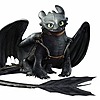HOME | DD
 PhilipEdwin — Tapinocephalus
PhilipEdwin — Tapinocephalus

#permian #synapsid #dinocephalia #tapinocephalus #tapinocephalid
Published: 2016-03-10 23:42:37 +0000 UTC; Views: 6482; Favourites: 68; Downloads: 8
Redirect to original
Description
Another speculatively furred synapsid. Yeah, I know I'm kinda pushing it here, but it still makes more sense than dressing it up in a modern lizards skin.Related content
Comments: 31

👍: 0 ⏩: 1

👍: 0 ⏩: 0

Cool. You made the tapinocephalus look like a guanaco, camel, or any other kind of even-toed ungulate. That's actually a creative idea when speculating what the purpose of it's large head is for (as well as symbolizing the fact that the therapsid itself was classified as a herbivore.
👍: 0 ⏩: 1

I'm happy with the idea, but not the result. I keep planning to completely rework this one day.
👍: 0 ⏩: 1

Oh well. Don't beat yourself up about it. I don't consider your picture to be a failure. So good luck with your remake on that picture.
👍: 0 ⏩: 0

I feel that it would be smarter to cloak them in Tuatara skin.
👍: 0 ⏩: 2

Synapsids don't have scales, since their skin integument evolved independently from that of reptiles. They had smooth gland-filled skin and sometimes fur.
👍: 0 ⏩: 1

We don't actually know if all of them had gland-filled skin.
👍: 0 ⏩: 1

Estemmenosuchus was a pretty basal tapinocephalid. Its highly likely that fully terrestrial relatives such as moschops and tapinocephalus had it as well, along with possibly fur (fur is a wee bit less likely, but again, it's not impossible.)
👍: 0 ⏩: 1

well I maintain we can't know for sure. Its certainly possible basal pelycosaurs had scales of some kind. Exactly what kind of scales is unknown. But fur on a pelycosaur.... However there is evidence to suggest that some therapsids had fur. And therocephalians and cynodonts are inferred to have had whiskers.
👍: 0 ⏩: 1

Pelycosaurs definitely had SOME scales. There are preserved skin impressions of Ophiacodon's belly. But these scales were not like those of reptiles. According to the paleontologists who found and examined the fossil, the scales on Ophiacodon's belly were more like the mammalian pseudo-scales found in rodents (the scales on a rat's tail, for example), or the scales of basal amniotes. The rest of the body, however, was bare skin. This probably applied to other pelycosaurs.
👍: 0 ⏩: 1

They were also likened to crocodile scutes.
👍: 0 ⏩: 0

But why? Dinocephalians like Tapinocephalus were proto-mammals and not even remotely related to the diapsid Tuataras.
👍: 0 ⏩: 1

true but the scales of some pelycosaurs are believed to be analogous to crocodilians which are similar to tuataras. Maybe not all of them, maybe the early ones like dimetrodon, but that's just me. or maybe they should have skin like a hippos. I don't know.
👍: 0 ⏩: 2

Unfortunately this article is partially paywalled, but the pelycosaur belly/tail scale patterns mimic the scutes on rodents like beavers and rats: www.tandfonline.com/doi/full/1…
Other dinocephalians like Estemmenosuchus had thick, glandular mammalian skin without scales or hair. Studies on Permian coprolites showcase that hair was present in the closely related therapsids. Hair impressions were found for docodonts and haramiyidans. Whiskers are inferred for therocephalians and cynodonts.
Here's a great, related article with the world's longest link address: watermark.silverchair.com/api/…
👍: 0 ⏩: 1

I just read that about dincephalians and I knew that Estemmenosuchus had thick glanduliar mammalian skin also the last link doesn't work. But it seems I have miscommunicated. I was disagreeing with the idea that dimetrodon had fur. Also check this link www.askabiologist.org.uk/answe…
👍: 0 ⏩: 1

Who knows when fur in synapsids evolved. Hair isn't a complicated structure and hair-like structures and a furry pelage have evolved independently in crustaceans, arachnids, insects, pterosaurs, amphibians, dinosaurs, molluscs and 23 different families of plants. Glandular skin is a far more complicated and advanced structure than hair/pycnofibers/setae/etc, which pops up everywhere.
One thing I can guarantee though, they didn't have skin like a tuatara, whose closest relatives are lizards and snakes. en.wikipedia.org/wiki/File:Tua…
👍: 0 ⏩: 1

probably not, but I can't think of any animal that has a scaly pelycosaur skin. Even if the impressions resemble mammal scutes, I'm not so sure that the early synapsids had scutes like that.
👍: 0 ⏩: 0

Apparently though at least some synapsids had fur, so Tapinocephalus maybe did.
👍: 0 ⏩: 0

I'm really lovin' how goat-like this depiction looks!
👍: 0 ⏩: 1

That sure looks different than the depictions we're used to see...
👍: 0 ⏩: 0

Yeah, I can see that too now.
My intention was to give it an eye similar to a goat or sheep, but with the ruff of fur over the ear hole, it makes it look like an owl's eye and facial disc.
👍: 0 ⏩: 0

Well executed! I think the furry look fits synapsids well. Nice to see more work from you.
👍: 0 ⏩: 1





















